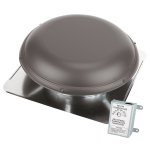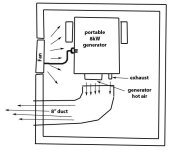jenkinsph
Super Star Member
If you want to duct cool air thru the compartment this is how I would do it.
Put in some 2x6 lumber to raise the floor with the lumber perpendicular to the front door.
Put plywood over the lumber leaving an opening across the back wall about six inches wide and a couple of cutouts directly beneath the genset.
An option to make it quieter would be to fasten 1" duct board insulation to the bottom side of this plywood floor.
Screen the front opening with hardware cloth to limit bugs and mice.
Install a piece of duct board on the ceiling with open ends for the air to flow through. Make this to allow about 8 inches short of the side walls of your compartment. I would make this baffle about 8" deep x 24" horizontal. Center the fan in the middle of trough of this baffle.
Install a vent fan in the roof with a vent thru the roof. Most have an adjustable thermostat you set from 90 to 135F. This could be a smaller residential size with lower fan noise. Extend the vent high enough for the snow in your locale.
Duct board is 1" fiberglass compressed insulation board used for hvac ducts. It is available in 4'x10' sheets for about $40-50, One sheet should be enough for this project. Any left over pieces I would use on the front wall. Available from most hvac supply stores.
A vent fan as pictured 1320 cfm with thermostat is about $60 to 75 plus a piece of single wall pipe to raise the dome above the roof for snow. Having this chimney of sorts will also help draft the air up as heat rises. Just have to clear the snow away from the lower opening at ground level.
Building the duct board plenum depends on the roof you have. If you have a ceiling inside that is flat and sealed you can form the duct board with out the top side and staple this to the ceiling. Shape it similar to the first picture. If you have open roof ceiling rafters then make the four sided plenum as in the second picture with the hole cut out for the fan in the top.
The main idea is to have padded ducts with turns to lower the noise levels. The exhaust and engine intake air should easily dissipate through these ducts. Set the thermostat to the lower setting on the thermostat and wire to the genset power outlet.
Put in some 2x6 lumber to raise the floor with the lumber perpendicular to the front door.
Put plywood over the lumber leaving an opening across the back wall about six inches wide and a couple of cutouts directly beneath the genset.
An option to make it quieter would be to fasten 1" duct board insulation to the bottom side of this plywood floor.
Screen the front opening with hardware cloth to limit bugs and mice.
Install a piece of duct board on the ceiling with open ends for the air to flow through. Make this to allow about 8 inches short of the side walls of your compartment. I would make this baffle about 8" deep x 24" horizontal. Center the fan in the middle of trough of this baffle.
Install a vent fan in the roof with a vent thru the roof. Most have an adjustable thermostat you set from 90 to 135F. This could be a smaller residential size with lower fan noise. Extend the vent high enough for the snow in your locale.
Duct board is 1" fiberglass compressed insulation board used for hvac ducts. It is available in 4'x10' sheets for about $40-50, One sheet should be enough for this project. Any left over pieces I would use on the front wall. Available from most hvac supply stores.
A vent fan as pictured 1320 cfm with thermostat is about $60 to 75 plus a piece of single wall pipe to raise the dome above the roof for snow. Having this chimney of sorts will also help draft the air up as heat rises. Just have to clear the snow away from the lower opening at ground level.
Building the duct board plenum depends on the roof you have. If you have a ceiling inside that is flat and sealed you can form the duct board with out the top side and staple this to the ceiling. Shape it similar to the first picture. If you have open roof ceiling rafters then make the four sided plenum as in the second picture with the hole cut out for the fan in the top.
The main idea is to have padded ducts with turns to lower the noise levels. The exhaust and engine intake air should easily dissipate through these ducts. Set the thermostat to the lower setting on the thermostat and wire to the genset power outlet.




